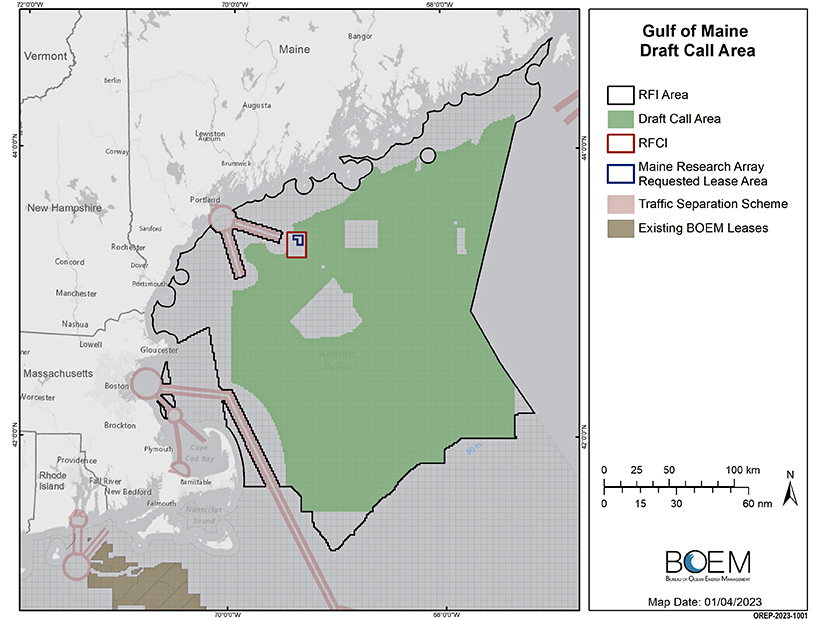The concept of floating wind power in the Gulf of Maine continues to take shape.
The U.S. Bureau of Ocean Energy Management on Tuesday wrapped up a series of informational sessions online and in person in Maine, Massachusetts and New Hampshire, seeking feedback as it develops a map of potential wind farm sites.
The eight-step process is intended to refine and shrink the initial planning area into individual lease areas, eliminating millions of acres less suited for wind power for reasons as varied as lobsters, pipelines, whales and commercial shipping.
There is more to come: Fisheries data, for example, have not been incorporated into planning yet.
The current “draft call area” is only Step 3 along the way and, at 9.9 million acres, is already 27% smaller than the area initially outlined.
“We recognize that this still a large area with significant conflict, and that’s really what we’re now turning our focus toward, looking toward the fishing effort, marine mammal and avian hotspots and any additional concerns that exist within this area,” BOEM project coordinator Zack Jylkka said Tuesday.
An audience member at the virtual meeting asked if a tract eliminated from the area of consideration could later be added back.
It typically would not be, Jylkka said. The process is slow and deliberative in hopes of avoiding the need for changes. But the ocean is a dynamic environment, so changes are sometimes needed, and BOEM is not precluded from making them, he said.
Has there been coordination with grid operators on the best interconnection points for electricity from offshore wind?
“One of the variables there is distance to shore, distance to interconnection points,” Jylkka said. “So, we’re certainly looking at that to inform some of the suitability of potential areas. But ultimately, we’re still asking a lot of questions ourselves.”
Is impact on endangered species weighted more than impact on nonendangered species?
The methodology has evolved in the last couple of years, said James Morris, a marine ecologist with the National Oceanic and Atmospheric Administration’s National Centers for Coastal Ocean Science. “We’ll essentially assign a score to each one of those species, based on its status and trend.”
A species with small and declining numbers would get a very low score for compatibility with a wind project, for example. All the scores for all the species are combined to produce a single data layer, to be added to the map with layers for the various other potential impacts.
The U.S. Department of the Interior in 2021 said it hoped to hold a lease sale in the Gulf of Maine by 2025. Jylkka said Tuesday that the auction is currently projected to be in the third quarter of 2024.
The offshore wind industry is still in its very early stages in the U.S., and the projects now being built and planned on the East Coast entail towers on seabed foundations. But the areas targeted for development in the Gulf of Maine, like those off the California coast, are deep enough to require anchored floating wind turbines, a technology still being developed and refined.
Five companies so far have expressed interest in potentially developing wind power in the gulf, Jylkka said: Avangrid Renewables, Hexicon USA, Pine Tree Offshore Wind (RWE Renewables and Diamond Offshore Wind), TotalEnergies SBE US (TotalEnergies and Simply Blue) and US Mainstream Renewable Power.
As large-scale commercial wind power is considered in the Gulf of Maine, the state of Maine is pressing forward on a related track: It has applied to BOEM for a research lease on 9,700 acres about 45 dozen miles southwest of Portland for up to a dozen floating turbines with a combined capacity of up to 144 MW.
The University of Maine has been designing and developing a floating concrete hull technology for offshore wind for more than a decade. A research array would advance that technology and give insight to the interaction floating wind turbines would have with fishing, shipping and other maritime activities and ecosystems.
On Jan. 19, BOEM announced a “determination of no competitive interest,” moving the state’s application to an environmental review of potential impacts from such a project.
The university, in a partnership that includes RWE and Diamond, is planning to anchor a single 10-MW floating turbine close to Monhegan Island in 2024. It is an up-scaled version of a turbine that was tested off the coast at Castine a decade ago.
Kelt Wilska, energy justice manager for Maine Conservation Voters and Maine’s lead representative in New England for Offshore Wind, told RTO Insider later Tuesday that he likes the progress being made.
“I view this through the lens of urgency,” he said. “We need to move very quickly to meet our climate goals both at the state and federal level.”
But there is value to a deliberative process, Wilska added.
BOEM was not required to hold the series of public meetings, he said. The fact that it did so indicates the agency is committed to a just and inclusive process, which is important to him and those he works with.
“I am pleased with the amount of care they are putting into winnowing down this area,” Wilska said.
The draft version of Maine’s own offshore wind roadmap shows the results of extensive outreach and collaboration, he added. “We want to really build on that.”




